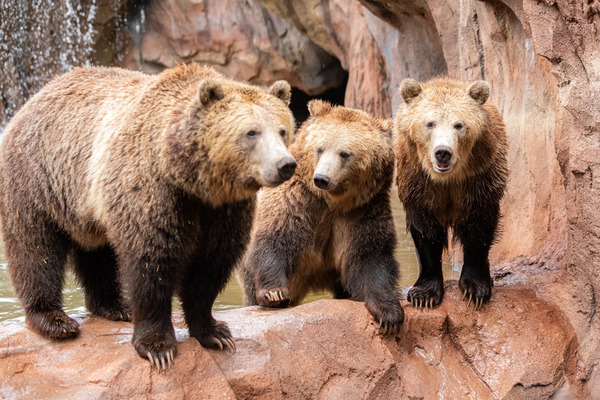Bears are fascinating creatures, and one of the most common questions people have is: What do bears eat? Bears are omnivores, meaning they eat both plants and animals, but the exact makeup of their diet depends on the species, season, and location. Whether it's a grizzly bear, a black bear, or a polar bear, their feeding habits can vary dramatically. In this comprehensive guide, we'll take a deep dive into the diets of different types of bears, what animals they hunt, and how they find food in the wild.
Black Bears
Polar Bears
Bear Prey: Mammals, Fish, and More
Insects and Other Small Creatures
How Bears Hunt
Scavenging and Carrion Feeding
Bears are often portrayed as large, powerful predators, but their diets are actually quite varied. Most bears are omnivores, which means they consume both plants and animals, depending on availability. However, the balance between plants and animal products in their diet can vary based on their species and the environment they live in. For instance, polar bears are more carnivorous, while black bears and grizzly bears are more opportunistic eaters, often switching between plants and animals based on what’s in season.
There are several species of bears, each with slightly different eating habits. Here’s a closer look at the dietary preferences of some of the most well-known bear species:
Grizzly bears, also known as brown bears, have a diverse diet that includes both plant and animal foods. They are primarily omnivorous but can be quite carnivorous at times, especially when food like fish (especially salmon) or small mammals are abundant. They are also known to hunt larger animals like moose and deer, but they often rely on scavenging for carrion during certain seasons.

Black bears have a flexible diet, which is why they are so adaptable to different environments. They primarily consume berries, nuts, and plants, but they will also hunt small mammals and fish when available. Like grizzly bears, black bears can also scavenge from other predators and are known to raid bird nests for eggs.
Polar bears are strict carnivores, with a diet almost entirely made up of meat. They primarily hunt seals, especially the ringed seal and bearded seal, which they hunt by waiting near breathing holes in the ice. Polar bears may also eat carcasses of whales and other large aquarium/52-marine-animals.html">marine animals, making them scavengers in some cases.
Bears are opportunistic eaters, and the specific animals they consume depend largely on what is available in their habitat. Here’s a breakdown of the types of animals that bears typically hunt or scavenge:
Fish: Many bears, especially grizzly bears and black bears, eat salmon and other fish, particularly during the spawning seasons when fish are abundant in rivers and streams.
Small Mammals: Bears will eat smaller mammals like squirrels, rabbits, mice, and voles. This is especially true for black bears, who are known to dig up burrows to find ground squirrels or marmots.
Larger Mammals: Some bears, especially grizzly bears, will hunt larger prey such as deer, moose, and elk. In areas with plentiful prey, these bears can even take down caribou or bison.
Carrion: Bears are also excellent scavengers and will often eat dead animals. This includes the carcasses of animals killed by other predators or those that have died naturally.
Insects: Bears are not above snacking on insects. Ants, beetles, and grubs are common snacks, and they are often found digging into rotting logs or digging up termite mounds.
Eggs: Bears will raid bird nests for eggs, and they are known to feast on the eggs of ground-nesting birds like geese and ducks.
Bears have unique eating habits that help them survive in diverse environments. Here's a closer look at how they feed:
Bears are typically solitary hunters, though they may be seen feeding together in places where food is abundant, like near rivers during salmon runs. They use their strong sense of smell to locate food and are highly skilled at catching prey, whether by fishing or hunting mammals.
Bears are opportunistic feeders, meaning that if they can’t find fresh prey, they will scavenge. This could include eating the remains of animals killed by other predators, such as wolves, cougars, or even humans. Bears will also take advantage of carrion left behind from roadkill or animals that have died from natural causes.
Bears are both predators and scavengers, which places them at a high trophic level in the food chain. As carnivores and omnivores, they help maintain a balance in the ecosystem by controlling the populations of smaller mammals and scavenging dead animals that other predators might overlook. This makes them an important part of the food web in their respective ecosystems.
Bears’ diets can change throughout the year based on what is available. For example:
Spring and Summer: Bears tend to eat a lot of plants, including berries, roots, and nuts, as well as insects and small mammals.
Fall: During the fall, many bears will gorge on salmon and other fish to build up fat reserves for the winter.
Winter: In the winter months, most bears enter hibernation, but if they are not hibernating, they will still hunt when food is available, often scavenging carrion.
Bears are incredibly adaptable animals, and their diets reflect this flexibility. Whether it’s through hunting large mammals, scavenging carrion, or feeding on plants and insects, bears have developed feeding habits that allow them to survive in a variety of environments. By understanding what animals bears eat and how they fit into the food chain, we gain a deeper appreciation for these remarkable creatures and their role in maintaining ecological balance.
animal tags: Bears
We created this article in conjunction with AI technology, then made sure it was fact-checked and edited by a Animals Top editor.